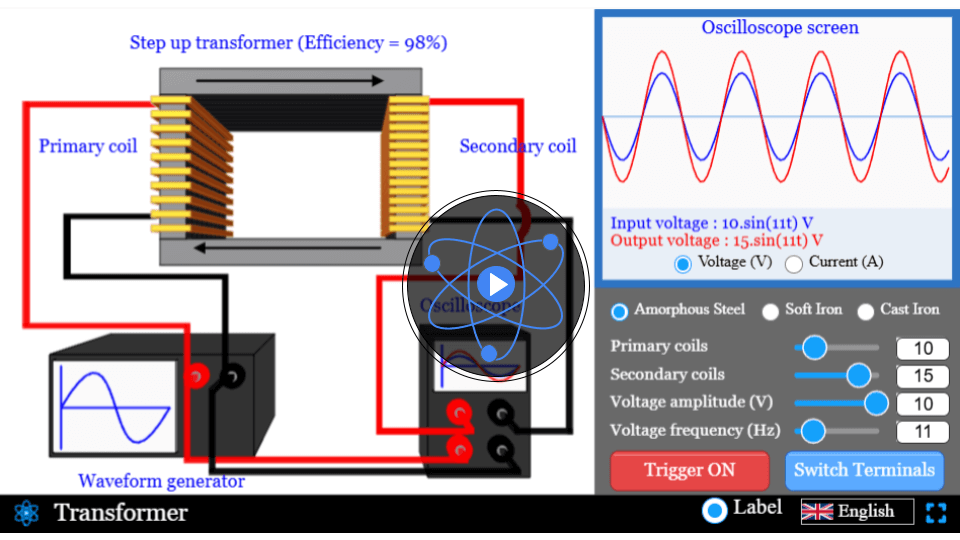Lenz's law simulator
Explore Lenz’s Law and observe the induced EMF when a magnet free-falls through a current-carrying coil with our interactive simulator.
Lenz's law
Have you ever wondered how a simple change in a magnetic field can induce an electric current in a coil? This phenomenon is explained by two key principles of electromagnetism: Faraday’s Law of Induction and Lenz’s Law.
Today, we’ll focus on the latter principle with our “Lenz’s Law simulator”. Our Lenz’s Law Simulator offers a thought experiment that allows you to visualize and understand how the induced current always opposes the change in magnetic flux. Dive in and explore the science of Lenz’s Law like never before!
\(\text{emf} = -\frac{d\Phi_B}{dt}\)
Mathematical description
where:
- \( \text{emf} \) is the induced electromotive force (EMF),
- \( \Phi_B \) is the magnetic flux
- \( t \) is the time
- negative sign indicates the opposition to the change in flux
Simulator
Explore Lenz’s Law with our interactive simulator! Visualize how changing magnetic fields induce opposing currents in conductors.
Interactive Physics Simulator – Lenz's Law
🌟 You May Also Like
Suggested experiments and activities based on your progress...
FAQs on Lenz's law
Qus 1. What is Lenz's Law?
Lenz’s Law is a fundamental principle in electromagnetism stating that the direction of an induced electric current in a conductor will oppose the change in the magnetic flux that produces it. This law is crucial in understanding how electromagnetic induction works in generators and transformers.
Qus 2. How's the electromotive force (emf) generated?
The production of electromotive force (EMF) is fundamentally caused by the interaction between a magnetic field and a conductor, rooted in the principles of electromagnetism. Here’s how it works:
Magnetic Flux Change: When there is a change in the magnetic flux (the number of magnetic field lines passing through a surface, like a loop of wire), it creates a condition where the magnetic environment within a conductor is not stable.
Faraday’s Law of Induction: According to Faraday’s Law, this change in magnetic flux induces an EMF in the conductor. The law states that the magnitude of the induced EMF is directly proportional to the rate of change of the magnetic flux.
Movement of Electrons: The changing magnetic field exerts a force on the free electrons in the conductor, causing them to move. This movement of electrons constitutes an electric current, and the EMF is the driving force behind this current.
Lenz’s Law: Lenz’s Law adds that the induced EMF will always act in such a direction that it opposes the change in magnetic flux that produced it. This opposition ensures that the induced current does not violate the law of conservation of energy.
Qus 3. How does Lenz's Law relate to the conservation of energy?
Lenz’s Law directly relates to the conservation of energy by ensuring that the induced current opposes the change in magnetic flux, preventing a scenario where energy would be created or destroyed, thereby maintaining energy balance in a system.
Qus 4. What is the mathematical expression for Lenz's Law?
The mathematical expression for Lenz’s Law is given by Faraday’s Law of Electromagnetic Induction, with an added negative sign:
\(\text{emf} = -\frac{d\Phi_B}{dt}\)
The negative sign indicates that the induced emf generates a current and magnetic field that oppose the change in magnetic flux.
Qus 5. What is an example of Lenz's Law?
A common example of Lenz’s Law is the behavior of a metal ring near a magnet. When the magnet is moved toward the ring, the changing magnetic field induces a current in the ring. According to Lenz’s Law, this induced current generates a magnetic field that opposes the movement of the magnet, effectively slowing it down.
Qus 6. Why is Lenz's Law important in electromagnetic induction?
Lenz’s Law is crucial in electromagnetic induction because it determines the direction of the induced current, which is essential for the correct operation of devices like electric generators, transformers, and induction cooktops. It helps in predicting and controlling the behavior of electrical circuits in varying magnetic fields
Qus 7. How does Lenz's Law affect the efficiency of electric generators?
In electric generators, Lenz’s Law creates a drag force that opposes the motion of the rotating parts. This opposition ensures the conservation of energy but also creates energy losses, particularly through friction and heat, affecting the generator’s overall efficiency.
Qus 8. How does Lenz's Law affect the design of electrical circuits?
Lenz’s Law impacts the design of electrical circuits by influencing factors such as inductance and resistance. Engineers must consider the opposing forces generated by induced currents to ensure that circuits function efficiently without unwanted energy losses or interference.
Qus 9. What are the applications of Lenz's Law in everyday life?
Lenz’s Law is applied in various everyday technologies, including braking systems in electric trains (eddy current brakes), metal detectors, and induction heating devices. These applications rely on the law to create opposing magnetic fields that control motion or generate heat.
Qus 10. How does Lenz's Law explain electromagnetic braking?
Electromagnetic braking uses Lenz’s Law to slow down moving objects, such as in trains. When a magnetic field interacts with the metal wheels or tracks, an induced current generates an opposing magnetic field that resists the motion, effectively slowing down the object without physical contact.
Qus 11. What are the limitations of Lenz's Law?
While Lenz’s Law is universally applicable, it doesn’t account for the energy losses due to resistance, hysteresis, or eddy currents in practical systems. These factors can affect the efficiency of electromagnetic devices, requiring additional considerations in design and operation.




